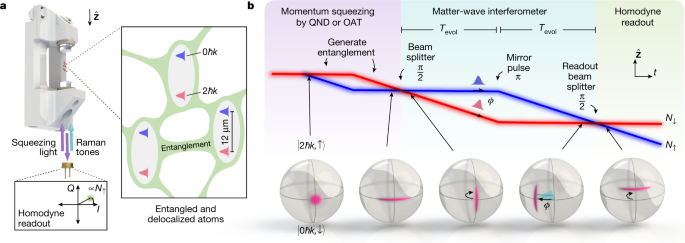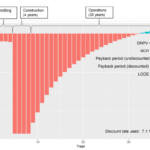2022-10-20 アメリカ国立標準技術研究所(NIST)
研究者たちは、標準量子限界(量子レベルでの実験的測定の精度の限界)を超える精度で加速度を感知できる物質波干渉計を初めて作り出した。
<関連情報>
- https://www.nist.gov/news-events/news/2022/10/entangled-matter-wave-interferometer-now-double-spookiness
- https://www.nature.com/articles/s41586-022-05197-9
高フィネス空洞におけるエンタングルメント強化物質波干渉計の開発 Entanglement-enhanced matter-wave interferometry in a high-finesse cavity
Graham P. Greve,Chengyi Luo,Baochen Wu & James K. Thompson
Nature Published:19 October 2022
DOI:https://doi.org/10.1038/s41586-022-05197-9

Abstract
An ensemble of atoms can operate as a quantum sensor by placing atoms in a superposition of two different states. Upon measurement of the sensor, each atom is individually projected into one of the two states. Creating quantum correlations between the atoms, that is entangling them, could lead to resolutions surpassing the standard quantum limit1,2,3 set by projections of individual atoms. Large amounts of entanglement4,5,6 involving the internal degrees of freedom of laser-cooled atomic ensembles4,5,6,7,8,9,10,11,12,13,14,15,16 have been generated in collective cavity quantum-electrodynamics systems, in which many atoms simultaneously interact with a single optical cavity mode. Here we report a matter-wave interferometer in a cavity quantum-electrodynamics system of 700 atoms that are entangled in their external degrees of freedom. In our system, each individual atom falls freely under gravity and simultaneously traverses two paths through space while entangled with the other atoms. We demonstrate both quantum non-demolition measurements and cavity-mediated spin interactions for generating squeezed momentum states with directly observed sensitivity 3.4+1.1−0.9 dB and 2.5+0.6−0.62.5−0.6+0.6 dB below the standard quantum limit, respectively. We successfully inject an entangled state into a Mach–Zehnder light-pulse interferometer with directly observed sensitivity 1.7+0.5−0.51.7−0.5+0.5 dB below the standard quantum limit. The combination of particle delocalization and entanglement in our approach may influence developments of enhanced inertial sensors17,18, searches for new physics, particles and fields19,20,21,22,23, future advanced gravitational wave detectors24,25 and accessing beyond mean-field quantum many-body physics26,27,28,29,30.



